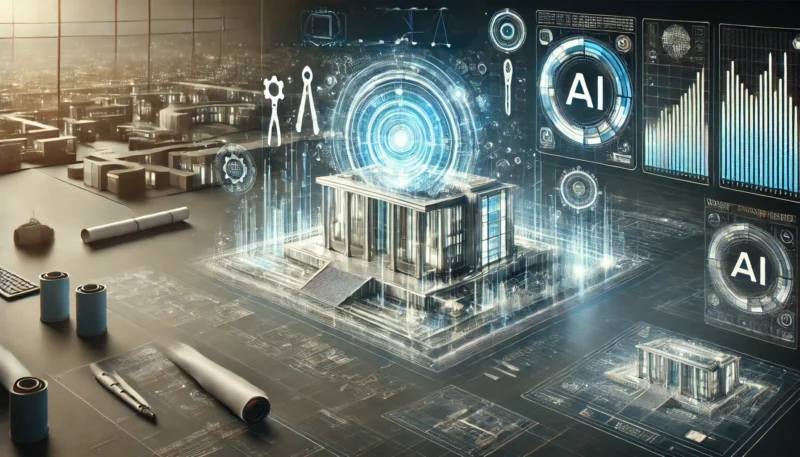
Best AI Tools for Architects in 2024: Boosting Design & Efficiency
In 2024, artificial intelligence (AI) is revolutionizing the field of architecture. Whether you’re an architect, urban planner, or designer, AI tools offer powerful ways to enhance productivity, boost creativity, and improve design efficiency. From generating optimized building plans to helping create photorealistic 3D renders, AI is streamlining processes that were once time-consuming and labor-intensive. In this article, we’ll explore the top 20 AI tools for architects in 2024 and how they’re changing the industry for the better.

Design Generation and Optimization
1. ARCHITEChTURES
One of the leading tools in architectural design generation is ARCHITEChTURES. This AI-powered platform helps architects create real-time optimized building designs. What makes ARCHITEChTURES unique is its ability to adhere to project requirements and local building regulations while optimizing designs for space utilization and energy efficiency. These factors are critical for modern, sustainable architecture. By handling these aspects automatically, the tool allows architects to focus more on creative solutions and the overall design vision.
- Key Features:
- Real-time design generation.
- Automated adherence to local building codes.
- Space and energy efficiency optimization.
2. Maket
Maket is another cutting-edge AI tool transforming residential design. It simplifies the process of generating floorplans and 3D renderings by using text-based prompts. Architects can enter specific requirements, and Maket will generate floorplans that fit the zoning regulations and style preferences of the project. This functionality saves architects countless hours and ensures that designs meet all necessary legal requirements.
Moreover, Maket’s ability to generate style variations based on text prompts allows architects to explore a wide range of design possibilities in minutes.
- Key Features:
- Automated floorplan creation based on text inputs.
- Zoning research and regulation adherence.
- 3D rendering for quick visualization.
3. ArkDesign.ai
ArkDesign.ai offers a comprehensive suite of tools for schematic design, making it ideal for early-stage planning. It generates floor plans optimized for profitability and efficiency, which is particularly valuable in commercial real estate development. By automating cost estimation and generating smart 3D renderings, ArkDesign.ai provides architects with actionable insights, enabling them to create designs that balance both aesthetic appeal and functional practicality.
- Key Features:
- Instant schematic design generation.
- Cost estimation and budgeting tools.
- Smart 3D rendering.
4. Spacemaker
Spacemaker, developed by Autodesk, is a groundbreaking AI tool that focuses on urban planning and sustainable architecture. This tool helps architects and urban planners evaluate various environmental and contextual factors, such as wind patterns, sunlight exposure, and noise levels. By integrating these factors early in the design process, Spacemaker enables teams to make more informed decisions, ultimately saving time and resources.
- Key Features:
- Environmental analysis.
- Sustainable design optimization.
- Integration with Autodesk platforms for seamless collaboration.
Visualization and Concept Design
5. Midjourney
Midjourney is revolutionizing the way architects conceptualize and visualize projects. With the ability to generate AI-assisted photorealistic images from simple text prompts, architects can quickly bring design ideas to life. This is particularly useful in the early stages of a project when architects are presenting concepts to clients and stakeholders. Midjourney allows for rapid exploration of creative possibilities, making it a valuable tool for conceptual design.
- Key Features:
- Photorealistic image generation from text prompts.
- Ideal for early-phase concept presentations.
- Quick iteration of creative design ideas.
6. Adobe Firefly
For architects who rely on Adobe’s suite of tools, Adobe Firefly is a game-changer. It integrates text-to-image generation and generative fill tools into Adobe’s ecosystem, such as Photoshop and Illustrator. By generating images based on simple text commands, Firefly enables architects to experiment with visual ideas faster and more efficiently. With support for over 100 languages, Firefly democratizes access to AI-driven design enhancements.
- Key Features:
- Integration with Adobe Creative Suite.
- Text-to-image generation for fast design visualizations.
- Supports over 100 languages for global accessibility.
7. DALL-E 3
DALL-E 3, developed by OpenAI, takes text-to-image generation to the next level. By allowing architects to input detailed prompts, DALL-E 2 can create visual representations of even the most complex architectural ideas. This tool helps during brainstorming sessions, enabling architects to explore a variety of design possibilities quickly. It’s especially helpful in generating inspiration or presenting initial ideas to clients.
- Key Features:
- Advanced text-to-image capabilities.
- Rapid visualization of complex architectural concepts.
- Ideal for concept exploration.
8. Stable Diffusion XL
Stable Diffusion XL is a tool for architects who need hyperrealistic renderings. This AI model provides enhanced color accuracy, contrast, and shadow detail, allowing architects to visualize buildings in great detail. It’s particularly useful for client presentations and design explorations, providing a near-perfect representation of the final product.
- Key Features:
- Hyperrealistic image rendering.
- Enhanced color and shadow accuracy.
- Excellent for detailed visualizations.
3D Modeling and Scanning
9. Luma AI
Luma AI specializes in creating photorealistic 3D content using Neural Radiance Fields (NeRF) technology. This tool is particularly useful for renovation projects where capturing the existing state of a structure is essential. By simply capturing video footage of an object or space, architects can generate highly accurate 3D models for use in further design stages.
- Key Features:
- 3D content generation from video captures.
- Ideal for renovation and restoration projects.
- Photorealistic modeling for better accuracy.
10. Kaedim
Kaedim is an AI tool that allows architects to turn 2D sketches into fully-realized 3D models. This capability speeds up the design process by eliminating the need for manual 3D modeling. Kaedim is perfect for architects who want to experiment with different design ideas without committing time to creating detailed models from scratch.
- Key Features:
- Fast 2D-to-3D model conversion.
- Simplifies the design exploration process.
- Excellent for early-stage concept development.
Building Information Modeling (BIM)
11. BricsCAD BIM
BricsCAD BIM combines the power of AI with Building Information Modeling (BIM) to streamline the design and construction process. It encourages collaboration between architects, engineers, and construction teams by automating repetitive tasks and offering insights that improve building quality. BricsCAD ensures that projects stay on track in terms of budget, schedule, and quality, making it a must-have tool for large-scale architectural projects.
- Key Features:
- AI-assisted BIM processes.
- Collaboration tools for cross-disciplinary teams.
- Automation of repetitive tasks.
12. Autodesk Forma
Another excellent AI-powered BIM tool, Autodesk Forma, helps architects manage complex design workflows. Forma provides real-time performance analysis and helps optimize building designs for energy efficiency and sustainability. With its collaboration tools, architects and designers can work more efficiently, ensuring the final design meets the project’s requirements while staying within the constraints of local regulations.
- Key Features:
- Real-time performance analysis.
- Design optimization for sustainability.
- Enhanced team collaboration.
Urban Planning
13. Sidewalk Labs
Sidewalk Labs, developed by Google, offers AI-driven solutions for urban planning. It focuses on addressing critical issues such as traffic management, energy efficiency, and housing affordability. This tool is especially useful for urban developers and architects working on large-scale projects where multiple factors must be considered simultaneously. By using AI, Sidewalk Labs generates smarter, more sustainable solutions that make cities more livable.
- Key Features:
- AI-driven solutions for urban challenges.
- Traffic management and housing optimization.
- Focus on sustainability and livability.
Project Management and Collaboration
14. ClickUp
ClickUp is a project management tool enhanced with AI, allowing architectural teams to automate tasks, track progress, and improve collaboration. With its customizable workflows, ClickUp adapts to the specific needs of architectural firms, ensuring that deadlines are met and resources are managed efficiently.
- Key Features:
- AI-enhanced project management.
- Customizable workflows for design studios.
- Task automation and progress tracking.
Rendering and Visualization Enhancement
15. Chaos AI Enhancer
Chaos AI Enhancer is a powerful tool for architects looking to improve the realism of their 3D renderings. Compatible with popular 3D modeling software like Enscape, it adds enhanced details to assets like vegetation, people, and shadows without compromising performance.
- Key Features:
- Realism enhancement for 3D renders.
- Performance optimization.
- Compatible with Enscape and other 3D tools.
16. Archicad AI Visualizer
Powered by Stable Diffusion, the Archicad AI Visualizer is designed to create quick, realistic 3D visualizations in the early stages of architectural design. By using simple text prompts, architects can explore different visual ideas and refine their designs without committing extensive time to manual renderings.
- Key Features:
- AI-powered 3D visualizations.
- Text-prompt-based design exploration.
- Ideal for early-stage design refinement.
Automation and Efficiency Tools
17. SketchUp
SketchUp has long been a staple in architectural design, and with AI integration, it has become even more powerful. The tool now features automated object recognition and smart placement, enabling architects to spend less time on repetitive tasks and more time on creative design.
- Key Features:
- AI-powered object recognition.
- Automation of repetitive tasks.
- Streamlined 3D modeling workflows.
18. AutoCAD
Another industry favorite, AutoCAD, now features AI integration for automated drafting and design tasks. AutoCAD’s AI tools help architects with intelligent object recognition, making it easier to place objects accurately and speed up the design process. Whether working on 2D or 3D drawings, AutoCAD’s AI capabilities improve overall efficiency.
- Key Features:
- AI-powered drafting automation.
- Intelligent object placement.
- Improved 2D and 3D drawing efficiency.
Virtual and Augmented Reality
19. Fologram
Fologram brings mixed reality to architectural design. Architects can now visualize their projects in real time, using augmented reality (AR) and virtual reality (VR). This makes collaboration and design reviews more interactive and immersive, allowing stakeholders to see the design in a virtual environment and suggest changes on the spot.
- Key Features:
- AR and VR integration.
- Real-time design visualization.
- Enhances collaboration and design reviews.
Sustainability and Energy Analysis
20. Delve
Delve focuses on helping architects design sustainable buildings and communities. By using machine learning, Delve generates the optimal design options based on energy performance, material usage, and environmental impact. This makes Delve an indispensable tool for architects who prioritize sustainability in their projects.
- Key Features:
- AI-generated sustainable design options.
- Energy and material usage optimization.
- Simplifies large-scale neighborhood design.
Embracing AI in Architecture
In 2024, AI tools are indispensable for architects. Whether you’re automating tasks with SketchUp and AutoCAD, generating photorealistic renders with Midjourney and Stable Diffusion XL, or optimizing urban planning with Sidewalk Labs, these tools are reshaping the way architects design, collaborate, and manage projects. As we continue to push the boundaries of design, the integration of AI will only increase, offering new possibilities for creativity, efficiency, and sustainability in architecture.
